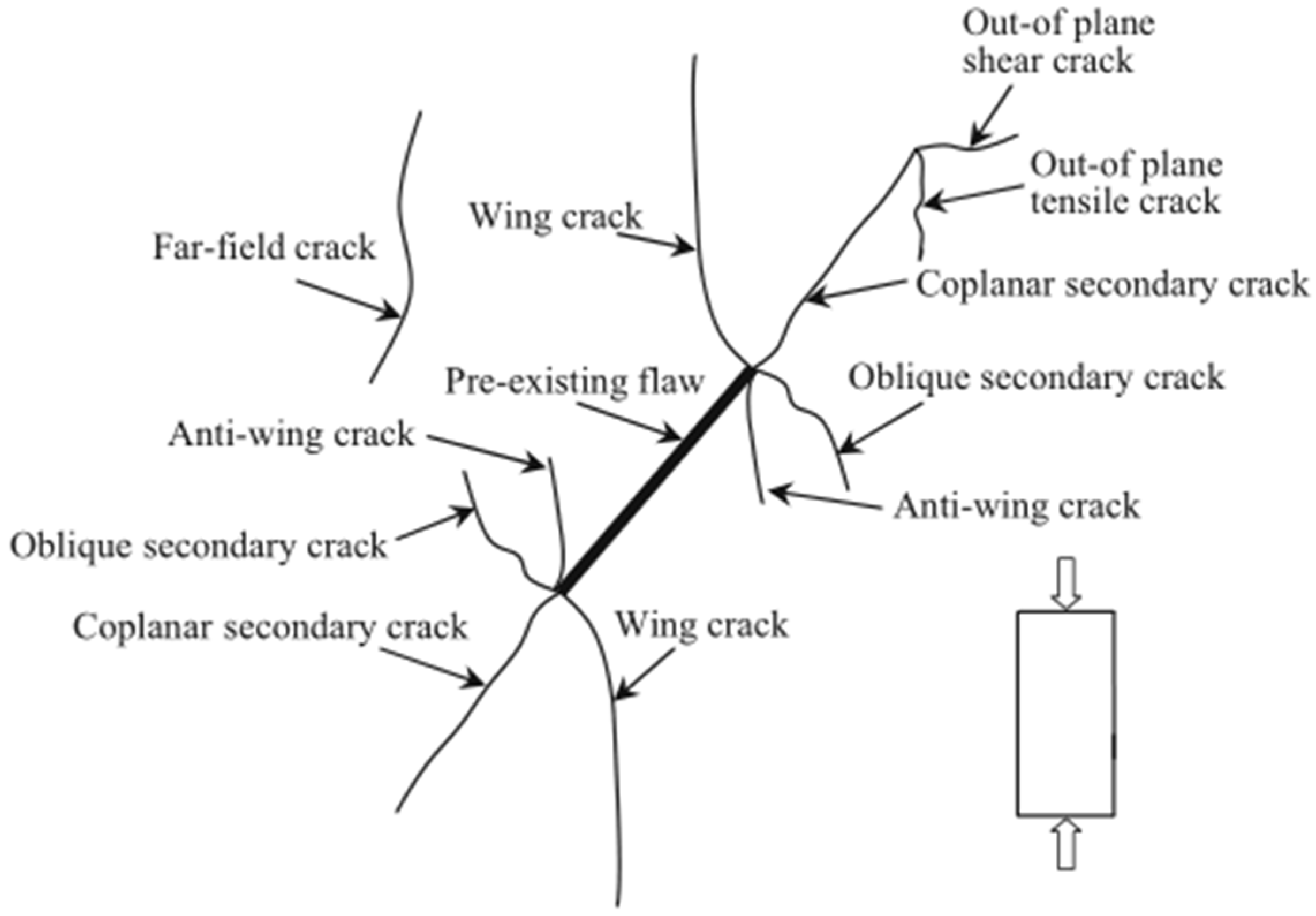Analysis of Micro-Evolution Mechanism of 3D Crack Initiation in Brittle Materials with Hole under Uniaxial Compression
Abstract
:1. Introduction
2. Materials and Methods
2.1. Selection of Similar Materials
2.2. Crack Parameters
2.3. Specimen Preparation and Testing Method
3. The Fracture Test Results and Analysis
3.1. Evolutionary Mode of Three-Dimensional Cracks
3.1.1. Cracks Inclination Angle α = 0° Situation
3.1.2. Crack Inclination Angle α = 30° Situation
3.1.3. Crack Inclination Angle α = 60° Situation
3.1.4. Crack Inclination Angle α = 90° Situation
3.2. Characteristics of Surface Cracks
- After the wing crack extends to a certain extent, it no longer follows the edge of the elliptical pre-existing crack and turns towards the surfaces on both sides of the specimen, resulting in surface cracks on the specimen with an almost vertical inclination, as shown in Figure 12I.
- When the wing-shaped cracks extend to the vicinity of the short axis ends of the elliptical pre-existing crack, spiral cracks appear. These spiral cracks extend to the lower side of the pre-existing crack, and during the rotation process, they reach the specimen surface, causing surface cracks. As illustrated in Figure 12II.
- As the axial load approaches the failure load, fishbone-like cracks and secondary cracks emerge, rapidly extending to the specimen surface. As illustrated in Figure 12III.
- Surface cracks resulting from the top and bottom cracking of the hole are depicted in Figure 12IV.
4. Numerical Simulation
4.1. Establishment of the Particle Flow Model
4.2. Determination of Microscopic Parameters
4.3. Validation of the Numerical Model
5. Microscopic Mechanism of Crack Evolution
5.1. Displacement Trend Line Method
5.2. Crack Initiation and Propagation Patterns
5.3. Microscopic Fracture Information Evolution Law
6. Conclusions
- A transparent, brittle material composed of epoxy resin, amine curing agent, and defoamer was developed, with a mixing ratio of 300:102:0.5. After low-temperature freezing, the tensile–compression ratio could reach 1/12 or more. This material could be used to study the initiation, propagation, and penetration damage patterns of internal cracks in brittle materials.
- Different inclination angles of the pre-existing cracks and different distances between the tips of the pre-existing cracks and the circular holes result in different crack initiation mechanisms being observed. When the inclination angle α of the prefabricated crack is 0°, tensile cracking occurs at the upper tip of the pre-existing crack, while wing-shaped tensile cracks and tensile–shear mixed cracks appear at the lower tip. When the inclination angle α of the prefabricated crack is 30°, no wing-shaped cracks appear, and the surface of the crack exhibits bifurcated tensile cracks only after the hole has cracked. At inclination angles of 60° and 90°, wing-shaped tensile cracks appear on the upper side of the pre-existing crack, while the anti-wing tensile crack and the anti-wing tensile–shear mixed crack appear on the lower side. Wing-shaped tensile cracks appear at the lower tip of the pre-existing crack, but with an increase in axial load, the extent of crack propagation is minimal, and ‘self-limiting’ phenomena occur in the vertical direction.
- As the crack extended to the surface of the specimen, the mechanism of crack propagation also changed. When the wing crack extended to both ends of the short axis of the pre-existing crack, a spiral crack appeared and extended to the underside of the pre-existing crack. During this process, the propagation mechanism transitioned from tensile cracking to tensile–shear mixed mode cracking. As the spiral crack extended to the surface of the specimen, generating surface cracks, the propagation mechanism transitioned from tensile–shear mixed mode to tensile cracking.
- The formation of surface cracks on the specimen can be summarized as being due to the following four situations:
- (1)
- After the wing crack extended to a certain extent, it no longer extended along the edge of the elliptical pre-existing crack, and the specimen’s surface turned towards both sides, extending to the specimen’s surface. The upward extension direction was almost perpendicular to the horizontal direction.
- (2)
- When the wing crack extended near the short axis of the elliptical pre-existing crack, spiral cracks appeared and extended downward to the surface of the specimen.
- (3)
- When the axial load approached the failure load, secondary cracks appeared and propagated instantaneously to the surface of the specimen.
- (4)
- Cracks are caused by cracking at the top and bottom of the hole.
Author Contributions
Funding
Institutional Review Board Statement
Informed Consent Statement
Data Availability Statement
Conflicts of Interest
References
- Abharian, S.; Sarfarazi, V.; Marji, M.F.; Rasekh, H. Experimental and numerical evaluation of the effects of interaction between multiple small holes and a single notch on the mechanical behavior of artificial gypsum specimens. Theor. Appl. Fract. Mech. 2022, 121, 103462. [Google Scholar] [CrossRef]
- Asadizadeh, M.; Khosravi, S.; Karimi, J.; Sherizadeh, T.; Vajedian, S.; Hossaini, M.F. Mechanical behavior of single-flawed cylindrical specimens subjected to axial loading: A numerical investigation. Bull. Eng. Geol. Environ. 2022, 81, 442. [Google Scholar] [CrossRef]
- Choo, J.; Sun, Y.; Fei, F. Size effects on the strength and cracking behavior of flawed rocks under uniaxial compression: From laboratory scale to field scale. Acta Geotech. 2023, 18, 3451–3468. [Google Scholar] [CrossRef]
- Haeri, H.; Sarfarazi, V.; Fatehi Marji, M. Experimental and Numerical Investigation of Uniaxial Compression Failure in Rock-Like Specimens with L-shaped Nonpersistent Cracks. Iran. J. Sci. Technol. Trans. Civ. Eng. 2021, 45, 2555–2575. [Google Scholar] [CrossRef]
- Sharafisafa, M.; Aliabadian, Z.; Tahmasebinia, F.; Shen, L. A comparative study on the crack development in rock-like specimens containing unfilled and filled flaws. Eng. Fract. Mech. 2021, 241, 107405. [Google Scholar] [CrossRef]
- Sharafisafa, M.; Shen, L. Experimental Investigation of Dynamic Fracture Patterns of 3D Printed Rock-like Material Under Impact with Digital Image Correlation. Rock Mech. Rock Eng. 2020, 53, 3589–3607. [Google Scholar] [CrossRef]
- Sharafisafa, M.; Shen, L.; Zheng, Y.; Xiao, J. The effect of flaw filling material on the compressive behaviour of 3D printed rock-like discs. Int. J. Rock Mech. Min. Sci. 2019, 117, 105–117. [Google Scholar] [CrossRef]
- Wang, H.; Qi, H.; Ren, X.; Tang, L.; Dong, Q. Stress Field of Structures with Internal Cracks by 3D-ILC Technology: Experimental and Numerical Analysis. KSCE J. Civ. Eng. 2022, 26, 248–259. [Google Scholar] [CrossRef]
- Li, H.; Wang, H.; Tang, L.; Ren, X.; Cai, Y. Fracture of brittle solid material containing a single internal crack of different depths under three-point bending based on 3D-ILC. Eng. Fract. Mech. 2021, 248, 107673. [Google Scholar] [CrossRef]
- Zhang, Z.; Wang, H.; Zhong, L.; Tang, L. Experimental and numerical research of the behavior of 3D internal cracks under uniaxial compression using 3D-ILC technology. Theor. Appl. Fract. Mech. 2023, 124, 103819. [Google Scholar] [CrossRef]
- Mahanta, B.; Vishal, V.; Sirdesai, N.; Ranjith, P.G.; Singh, T.N. Progressive deformation and pore network attributes of sandstone at in situ stress states using computed tomography. Eng. Fract. Mech. 2021, 252, 107833. [Google Scholar] [CrossRef]
- Damaskinskaya, E.E.E.; Hilarov, V.L.; Panteleev, I.A.; Gafurova, D.R.; Frolov, D.I. Statistical Regularities of Formation of a Main Crack in a Structurally Inhomogeneous Material under Various Deformation Conditions. Phys. Solid State 2018, 60, 821–1826. [Google Scholar] [CrossRef]
- Maji, V.; Murton, J.B. Micro-computed tomography imaging and probabilistic modelling of rock fracture by freeze–thaw. Earth Surf. Process. Landf. 2020, 45, 666–680. [Google Scholar] [CrossRef]
- Akhondzadeh, H.; Keshavarz, A.; Al-Yaseri, A.Z.; Ali, M.; Awan, F.U.R.; Wang, X.; Yang, Y.; Iglauer, S.; Lebedev, M. Pore-scale analysis of coal cleat network evolution through liquid nitrogen treatment: A Micro-Computed Tomography investigation. Int. J. Coal Geol. 2020, 219, 103370. [Google Scholar] [CrossRef]
- Li, Z.; Wang, L.; Jiang, C.; Lu, Y.; Li, W. Three-dimensional fracture evolution patterns of rocks under true triaxial conditions based on real-time CT scanning. J. China Coal Soc. 2021, 46, 937–949. [Google Scholar]
- Li, Z.; Wang, L.; Wang, L.; Fan, H.; Ren, B.; Ding, K. Study on the Evolution of Rock Fracture under True Triaxial Intermediate Principal Stress. Int. J. Geomech. 2024, 24, 4023254. [Google Scholar] [CrossRef]
- Yang, B.; Xue, L.; Zhang, K. X-ray micro-computed tomography study of the propagation of cracks in shale during uniaxial compression. Environ. Earth Sci. 2018, 2018, 77–652. [Google Scholar] [CrossRef]
- Torres, S.M.; Vorobiev, O.Y.; Robey, R.E.; Hargather, M.J. A study of explosive-induced fracture in polymethyl methacrylate (PMMA). J. Appl. Phys. 2023, 134, 75103. [Google Scholar] [CrossRef]
- Bahmani, A.; Aliha, M.R.M.; Sarbijan, M.J.; Mousavi, S.S. An extended edge-notched disc bend (ENDB) specimen for mixed-mode I+II fracture assessments. Int. J. Solids Struct. 2020, 193–194, 239–250. [Google Scholar] [CrossRef]
- Pirmohammad, S.; Mengharpey, M.H. A new mixed mode I/II fracture test specimen: Numerical and experimental studies. Theor. Appl. Fract. Mech. 2018, 97, 204–214. [Google Scholar] [CrossRef]
- Zhou, T.; Zhu, J.B.; Ju, Y.; Xie, H.P. Volumetric fracturing behavior of 3D printed artificial rocks containing single and double 3D internal flaws under static uniaxial compression. Eng. Fract. Mech. 2019, 205, 190–204. [Google Scholar] [CrossRef]
- Li, B.; Yu, S.; Zhu, W.; Cai, W.; Yang, L.; Xue, Y.; Li, Y. The Microscopic Mechanism of Crack Evolution in Brittle Material Containing 3-D Embedded Flaw. Rock Mech. Rock Eng. 2020, 53, 5239–5255. [Google Scholar] [CrossRef]
- Wang, H.; Dyskin, A.; Pasternak, E.; Dight, P. Possible mechanism of spallation in rock samples under uniaxial compression. Eng. Fract. Mech. 2022, 269, 108577. [Google Scholar] [CrossRef]
- Wang, H.; Dyskin, A.; Pasternak, E.; Dight, P.; Jeffcoat-Sacco, B. Fracture mechanics of spallation. Eng. Fract. Mech. 2022, 53, 3161–3183. [Google Scholar] [CrossRef]
- Wang, H.; Dyskin, A.; Pasternak, E.; Dight, P.; Sarmadivaleh, M. Effect of the intermediate principal stress on 3-D crack growth. Eng. Fract. Mech. 2018, 204, 404–420. [Google Scholar] [CrossRef]
- Wang, H.; Dyskin, A.; Pasternak, E. Comparative analysis of mechanisms of 3-D brittle crack growth in compression. Eng. Fract. Mech. 2019, 220, 106656. [Google Scholar] [CrossRef]
- Wang, H.; Dyskin, A.; Pasternak, E.; Dight, P. 3D Crack Growth in Biaxial Compression: Influence of Shape and Inclination of Initial Cracks. Rock Mech. Rock Eng. 2020, 53, 3161–3183. [Google Scholar] [CrossRef]
- Dyskin, A.V.; Sahouryeh, E.; Jewell, R.J.; Joer, H.; Ustinov, K.B. Influence of shape and locations of initial 3-D cracks on their growth in uniaxial compression. Eng. Fract. Mech. 2003, 2003, 2115–2136. [Google Scholar] [CrossRef]
- Adams, M.; Sines, G. Crack extension from flaws in a brittle material subjected to compression. Tectonophysics 1978, 49, 97–118. [Google Scholar] [CrossRef]
- Yin, Q.; Jing, H.; Su, H. Investigation on mechanical behavior and crack coalescence of sandstone specimens containing fissure-hole combined flaws under uniaxial compression. Geosci. J. 2018, 22, 825–842. [Google Scholar] [CrossRef]
- Sagong, M.; Park, D.; Yoo, J.; Lee, J.S. Experimental and numerical analyses of an opening in a jointed rock mass under biaxial compression. Int. J. Rock Mech. Min. Sci. 2011, 48, 1055–1067. [Google Scholar] [CrossRef]
- Yang, S.Q.; Yin, P.F.; Zhang, Y.C.; Chen, M.; Zhou, X.P.; Jing, H.W.; Zhang, Q.Y. Failure behavior and crack evolution mechanism of a non-persistent jointed rock mass containing a circular hole. Int. J. Rock Mech. Min. Sci. 2019, 114, 101–121. [Google Scholar] [CrossRef]
- Chen, M.; Jing, H.; Ma, X.; Su, H.; Du, M.; Zhu, T. Fracture evolution characteristics of sandstone containing double fissures and a single circular hole under uniaxial compression. Int. J. Min. Sci. Technol. 2017, 27, 499–505. [Google Scholar] [CrossRef]
- Yao, D.; Jiang, N.; Wang, X.; Jia, X.; Lv, K. Mechanical behaviour and failure characteristics of rocks with composite defects of different angle fissures around hole. Bull. Eng. Geol. Environ. 2022, 817, 290. [Google Scholar] [CrossRef]
- Cheng, H.; Zhou, X.; Zhu, J.; Qian, Q. The effects of crack openings on crack initiation, propagation and coalescence behavior in rock-like materials under uniaxial compression. Rock Mech. Rock Eng. 2016, 49, 3481–3494. [Google Scholar] [CrossRef]
- Sagong, M.; Bobet, A. Coalescence of multiple flaws in a rock-model material in uniaxial compression. Int. J. Rock Mech. Min. Sci. 2002, 39, 229–241. [Google Scholar] [CrossRef]
- Zhang, X.; Wong, L.N.Y. Displacement field analysis for cracking processes in bonded-particle model. Bull. Eng. Geol. Environ. 2014, 73, 13–21. [Google Scholar] [CrossRef]
- Fremy, F.; Pommier, S.; Galenne, E.; Courtin, S.; Le Roux, J.C. Load path effect on fatigue crack propagation in I + II + III mixed mode conditions—Part 2: Finite element analyses. Int. J. Fatigue 2014, 62, 113–118. [Google Scholar] [CrossRef]
- Vormwald, M.; Hos, Y.; Freire, J.L.; Gonzáles, G.L.; Díaz, J.G. Variable mode-mixity during fatigue cycles—Crack tip parameters determined from displacement fields measured by digital image correlation. Frat. Integrità Strutt. 2017, 11, 314–322. [Google Scholar] [CrossRef]
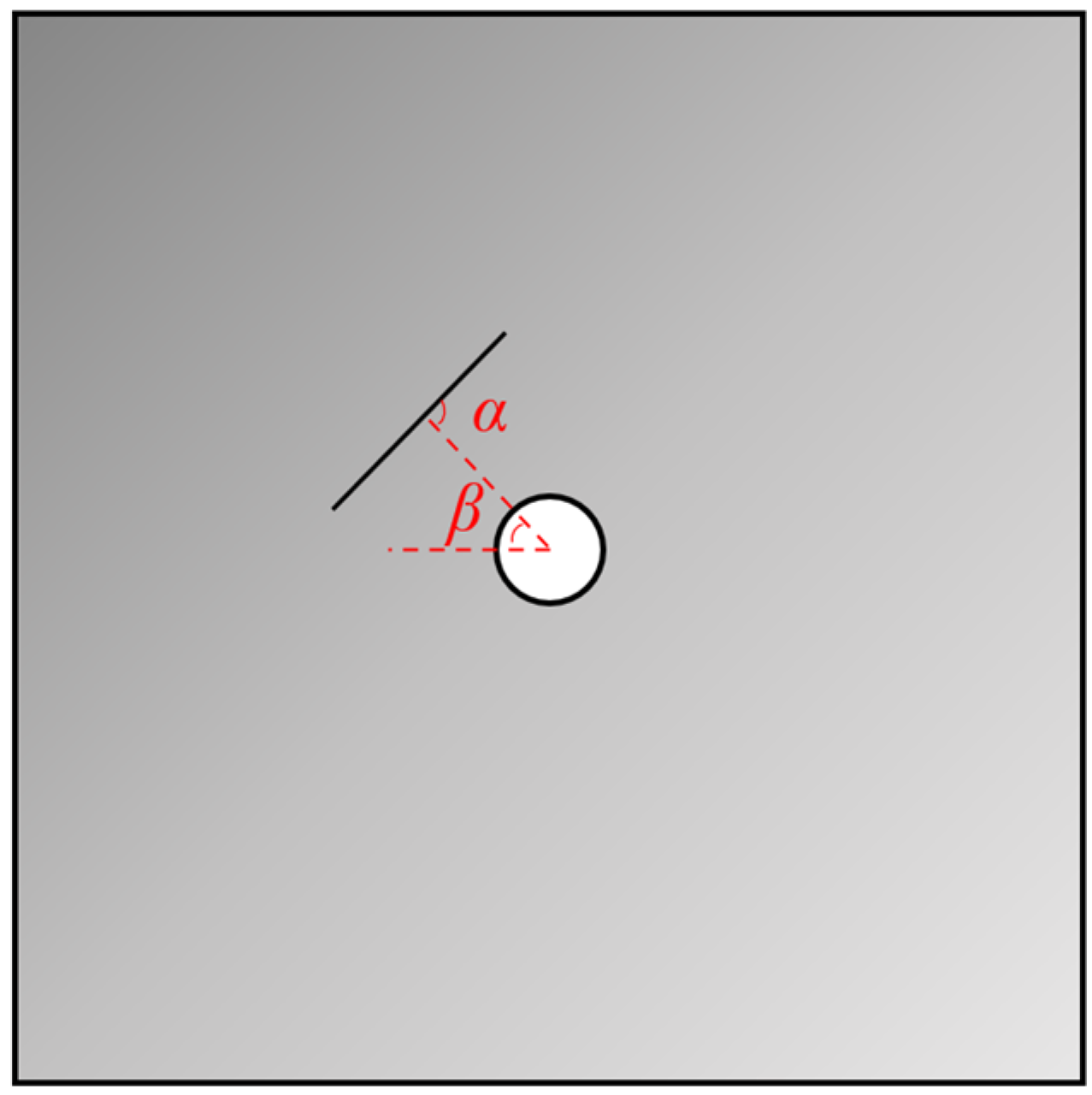


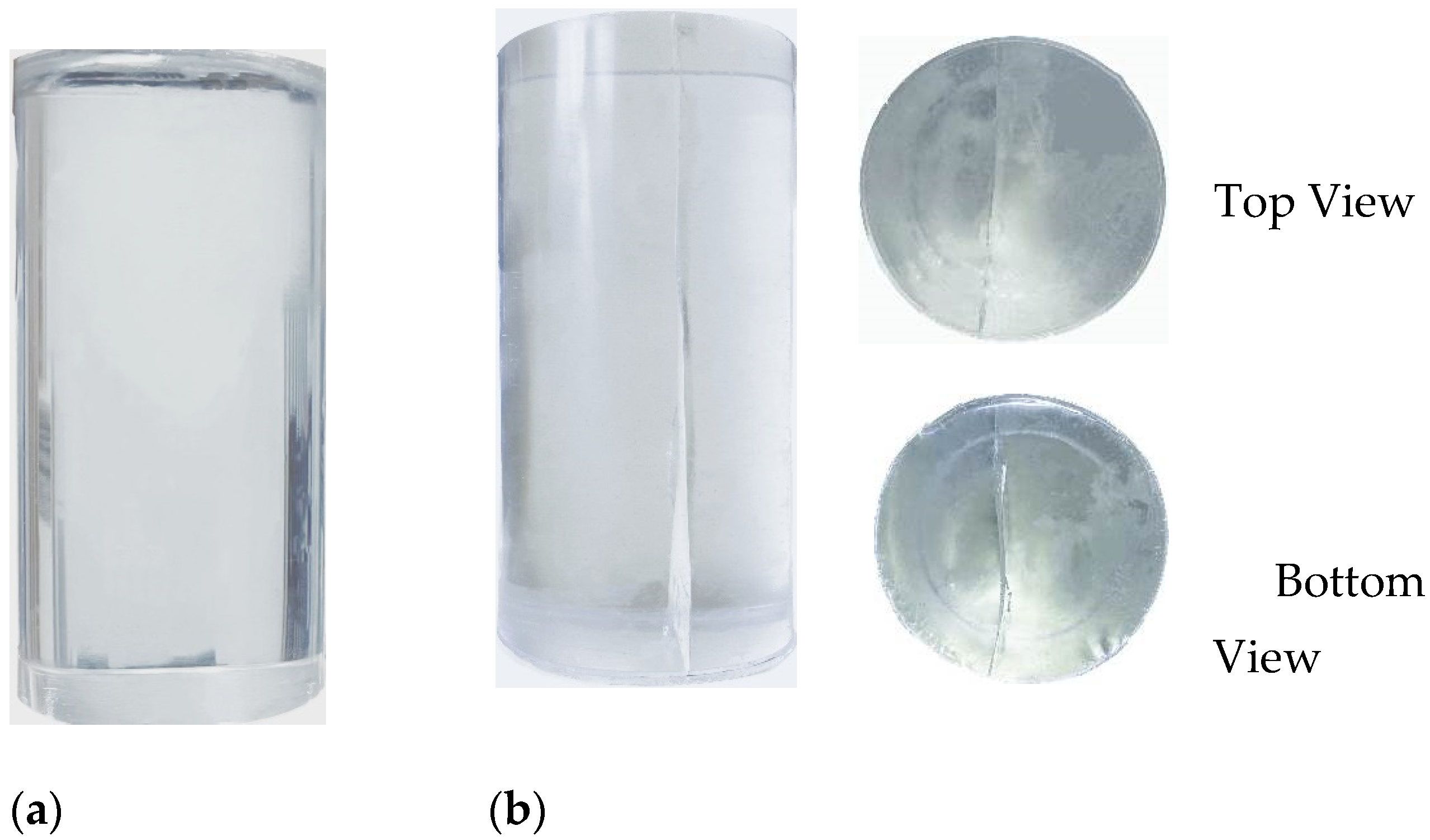
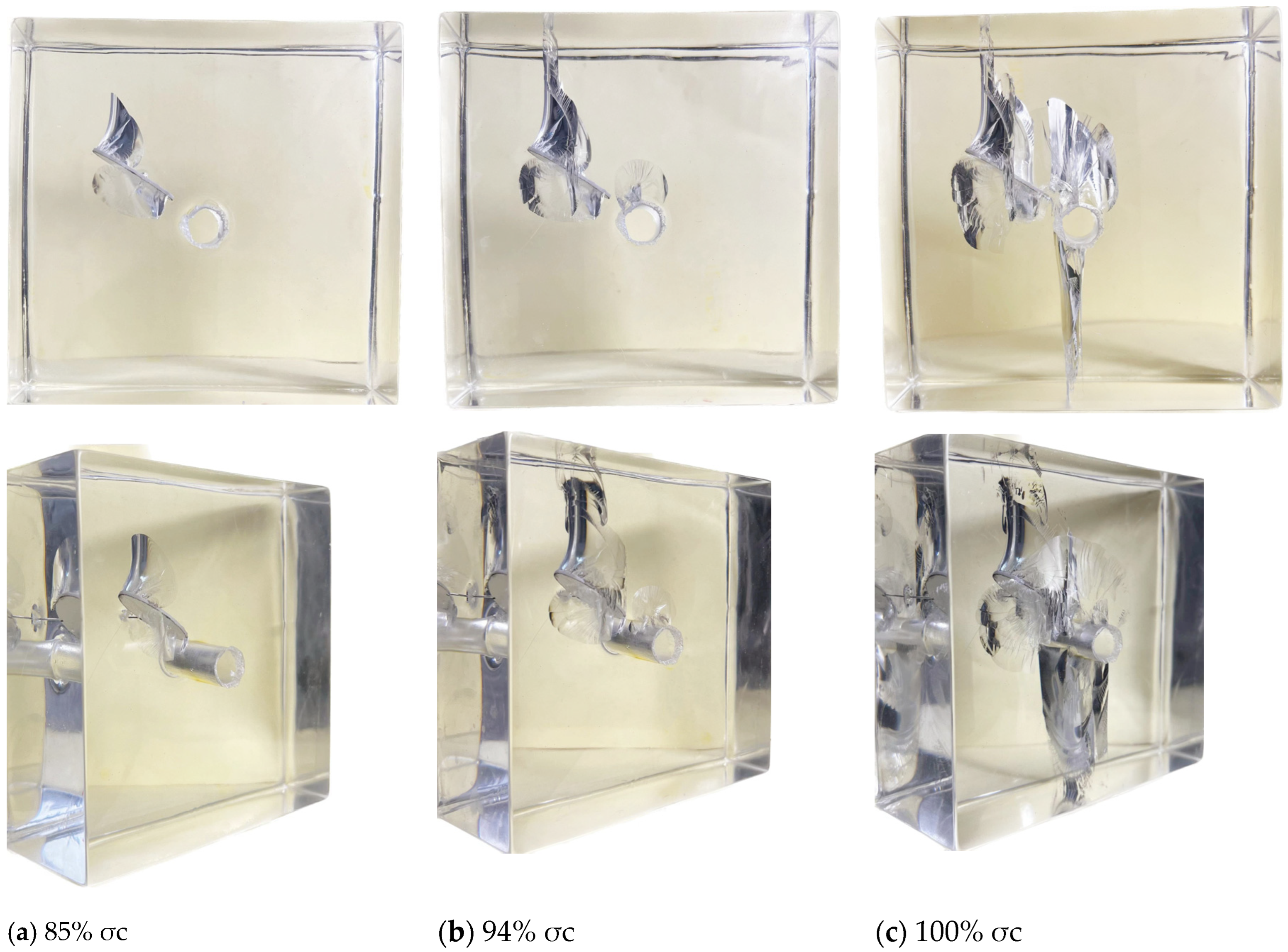
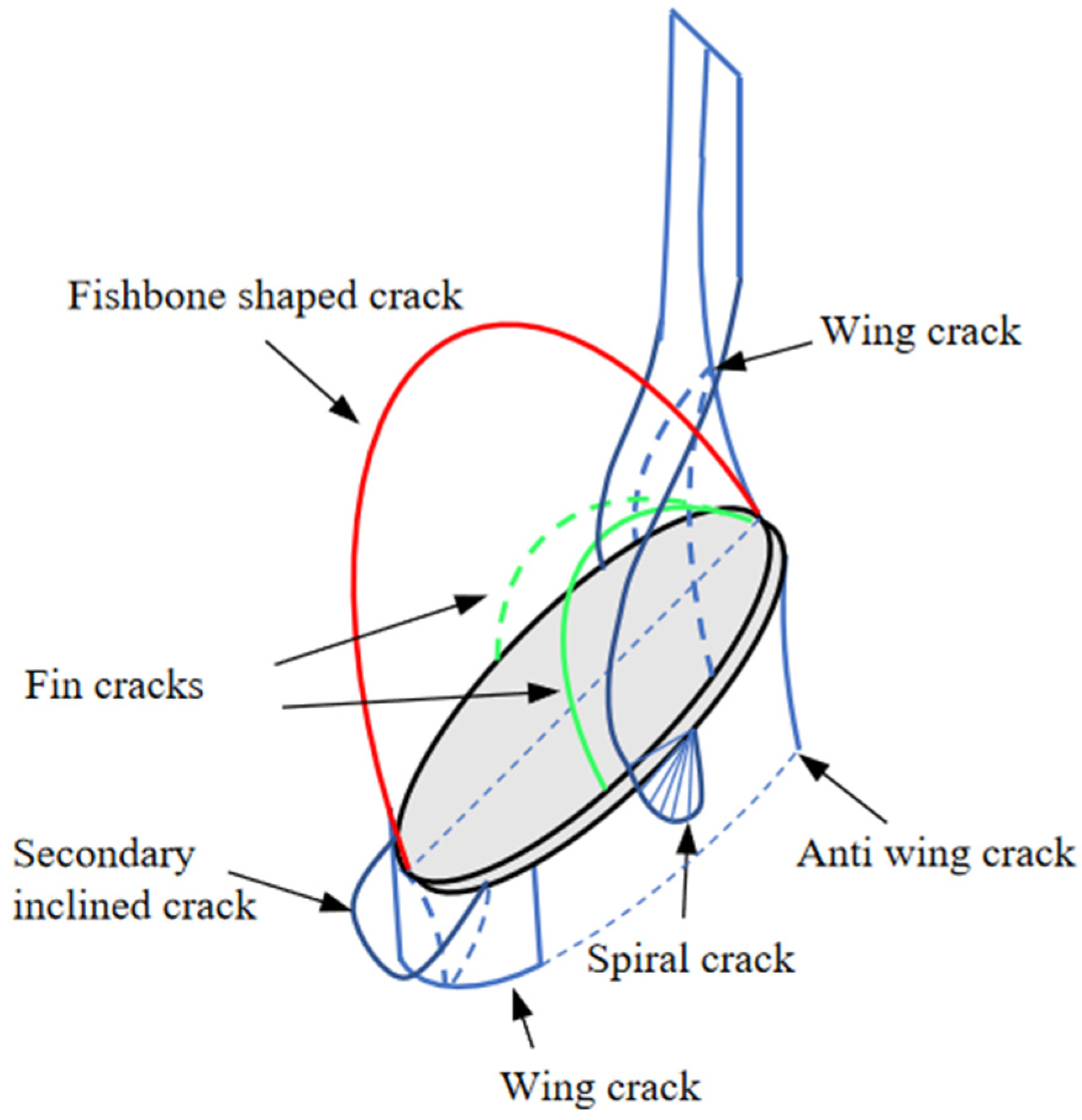



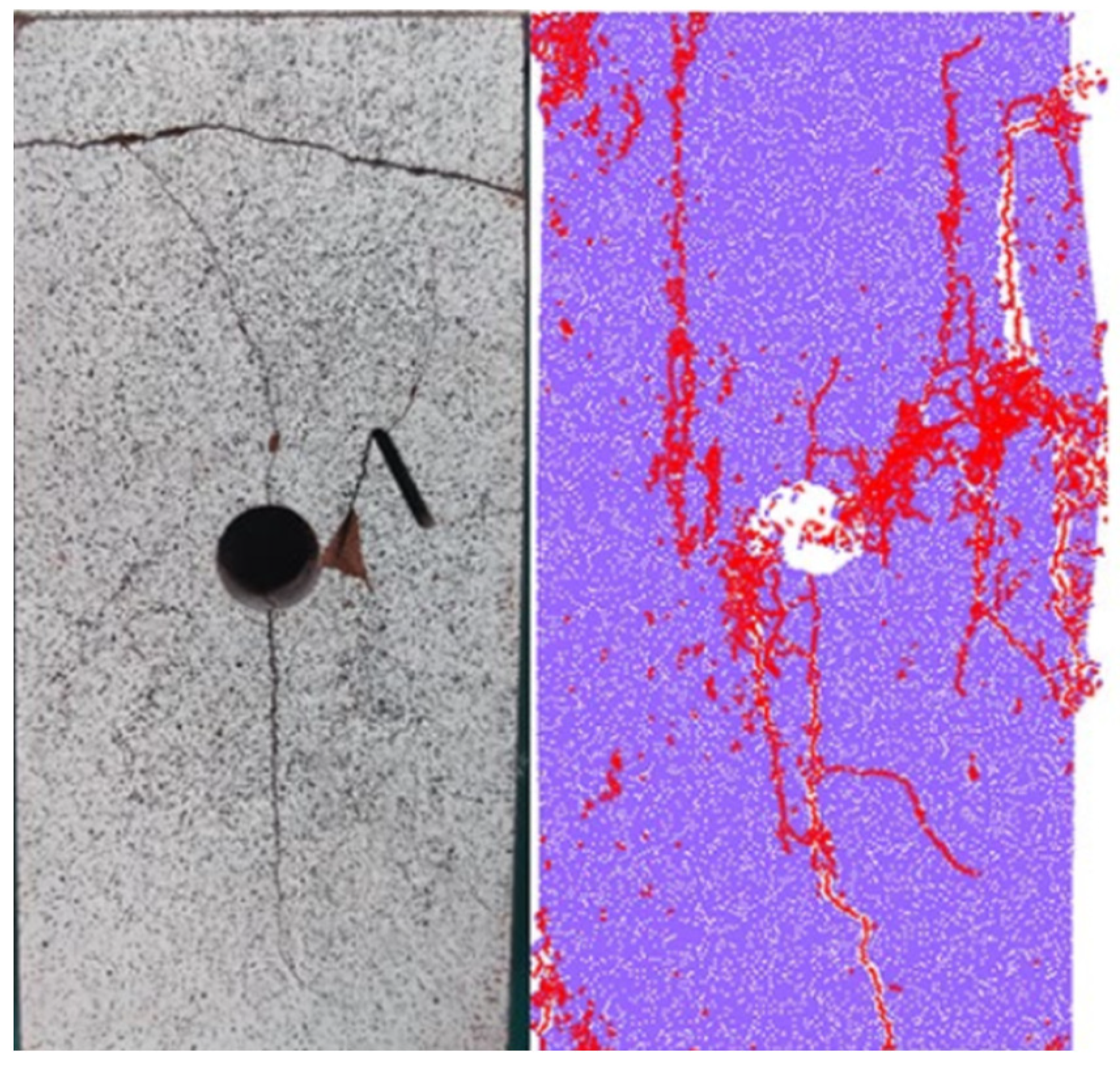


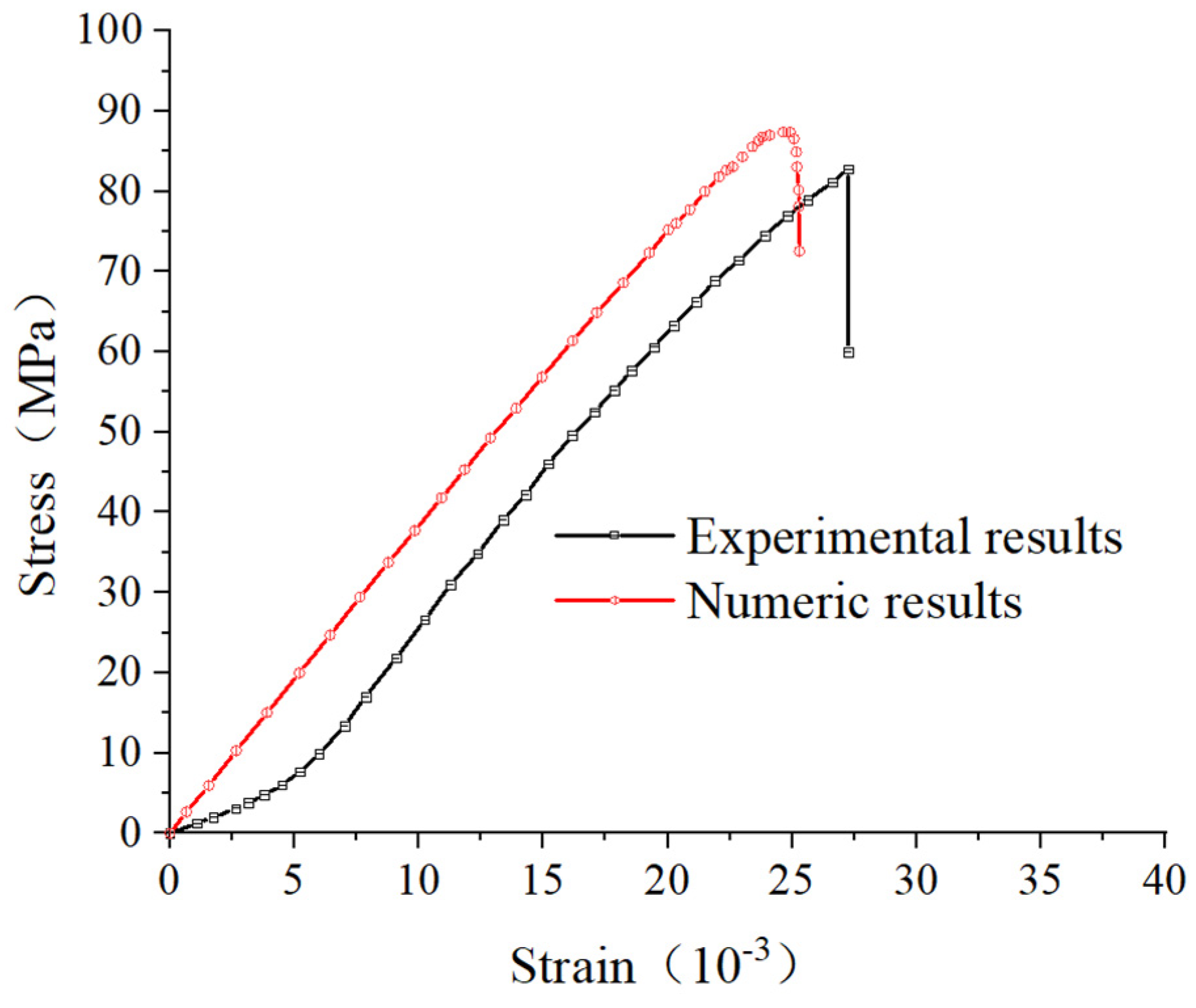
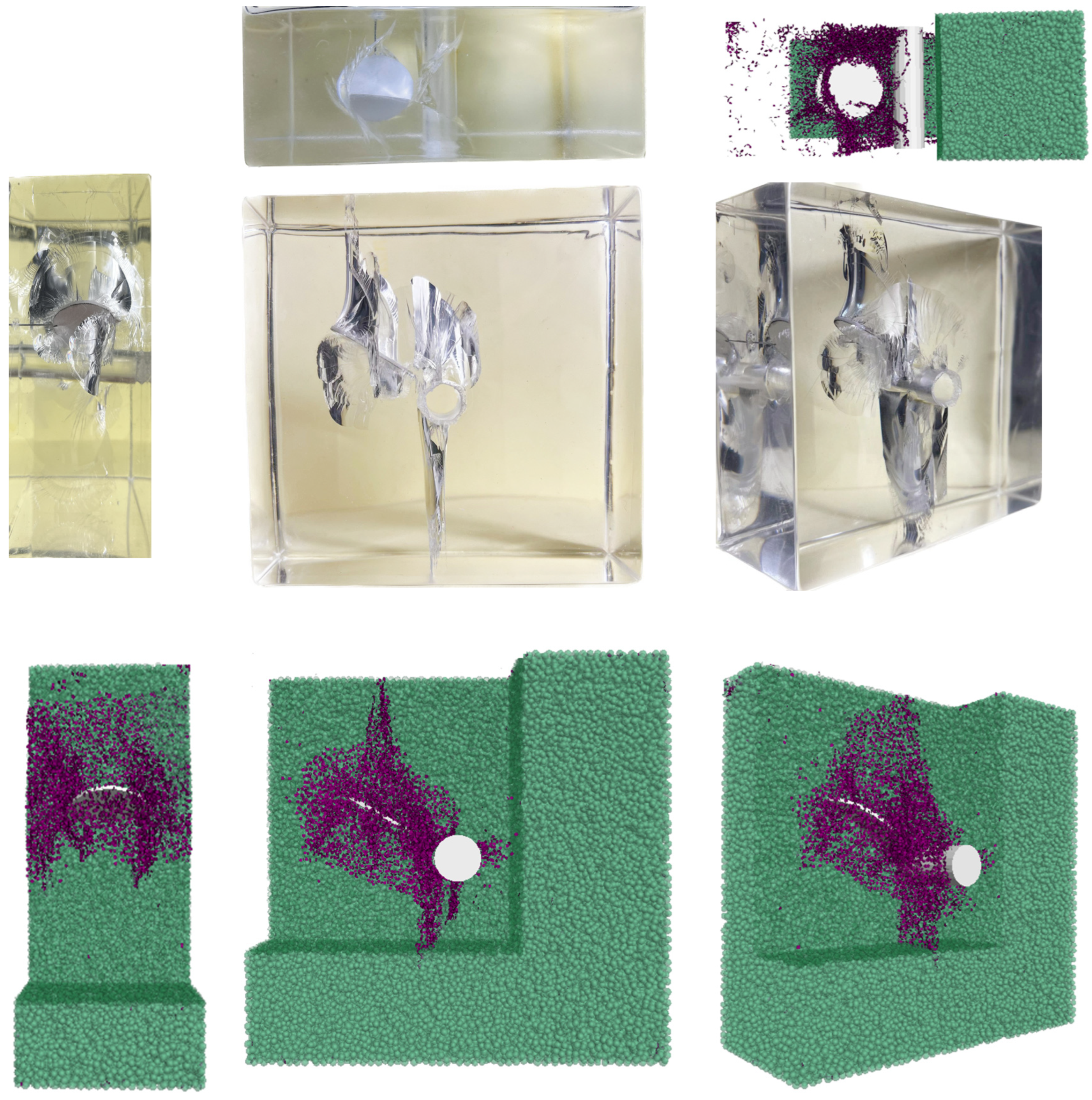

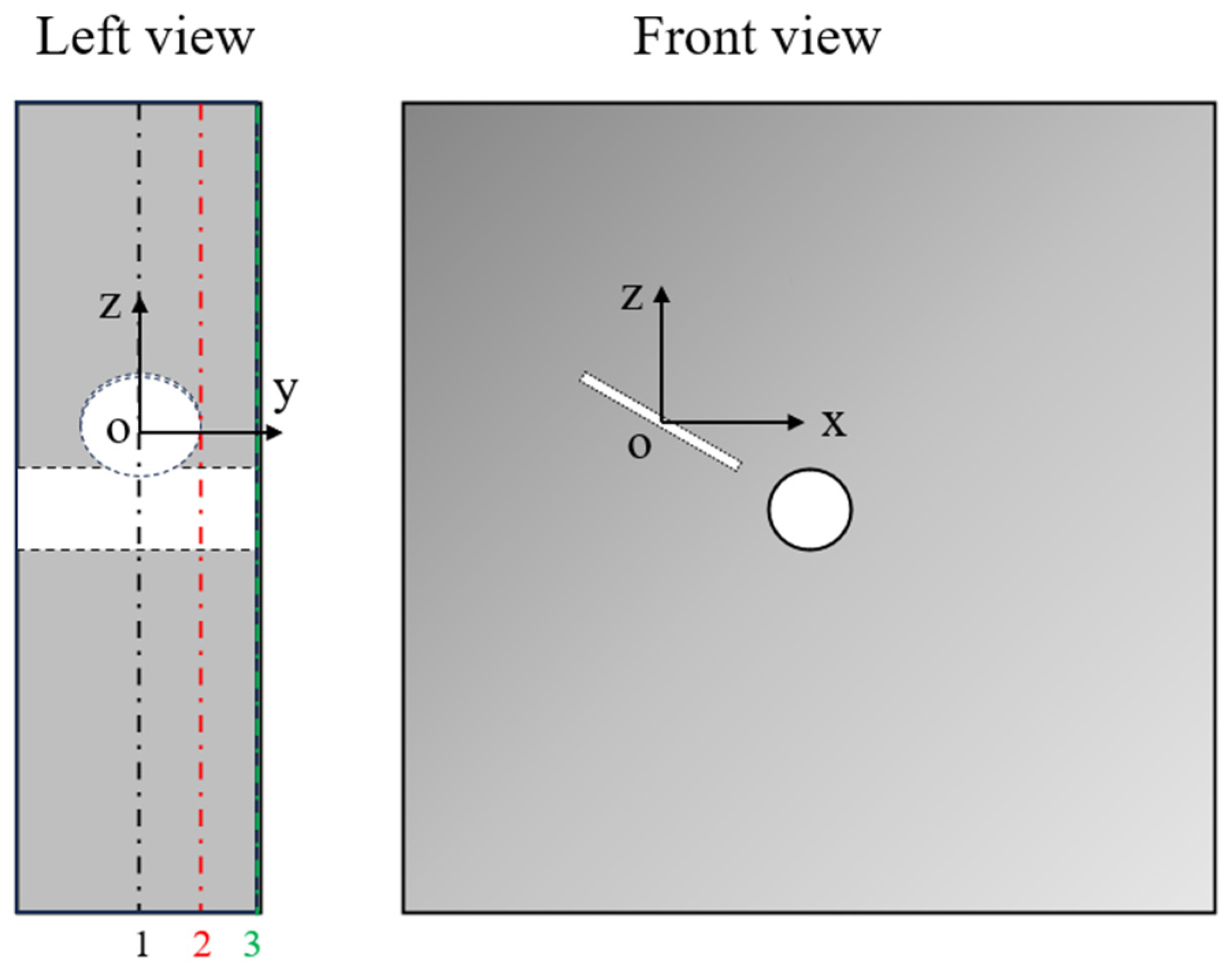

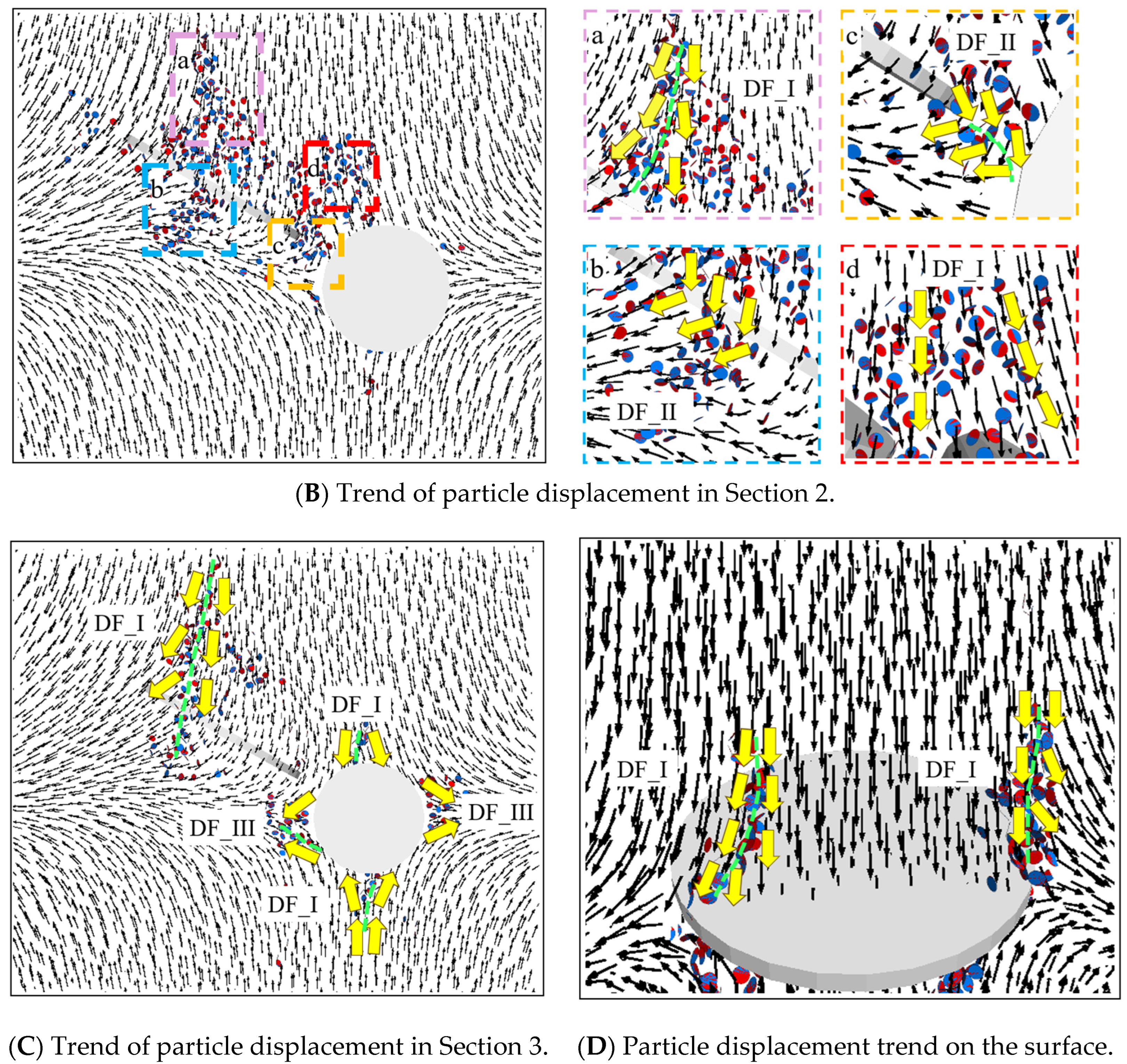
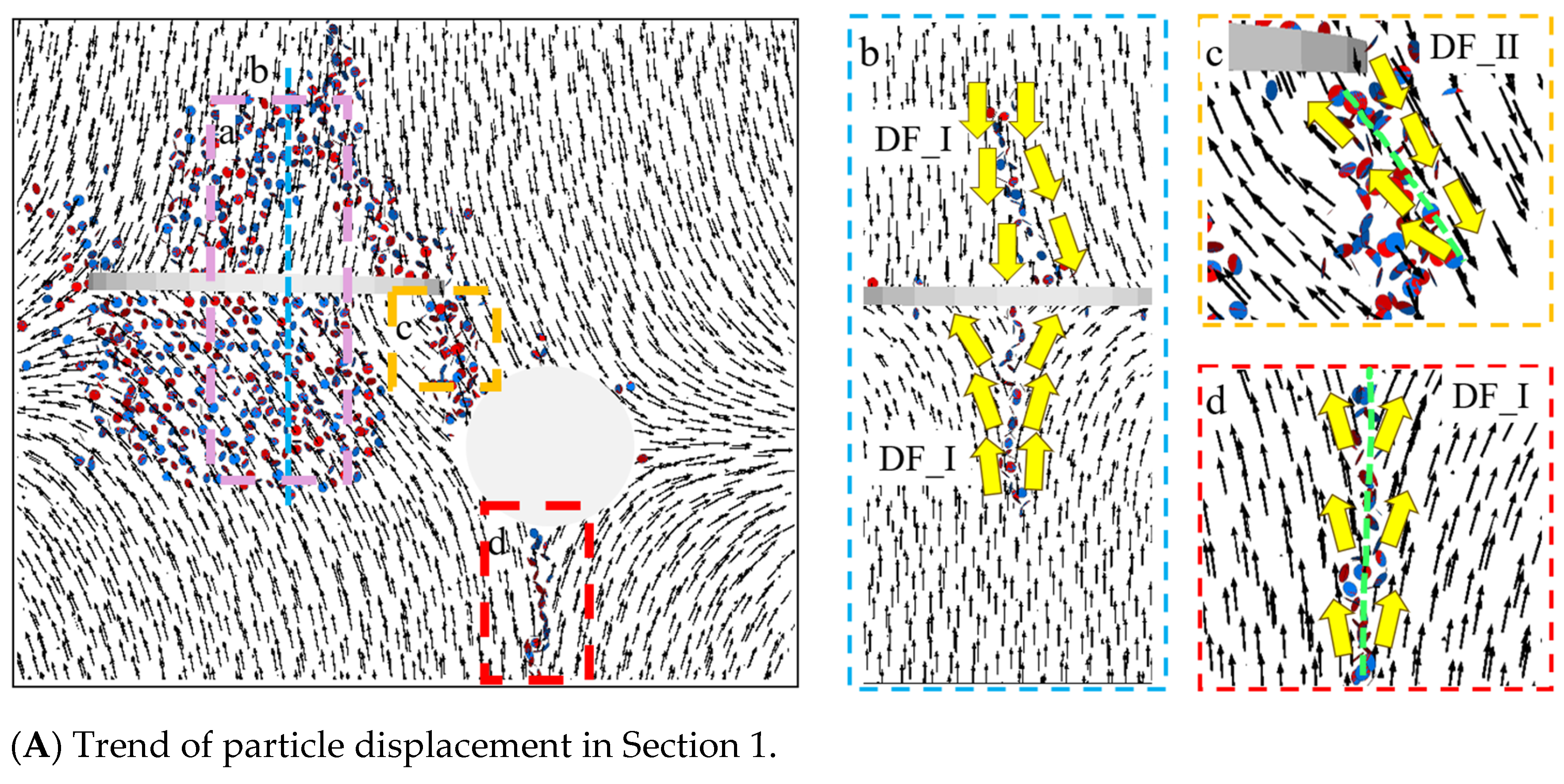
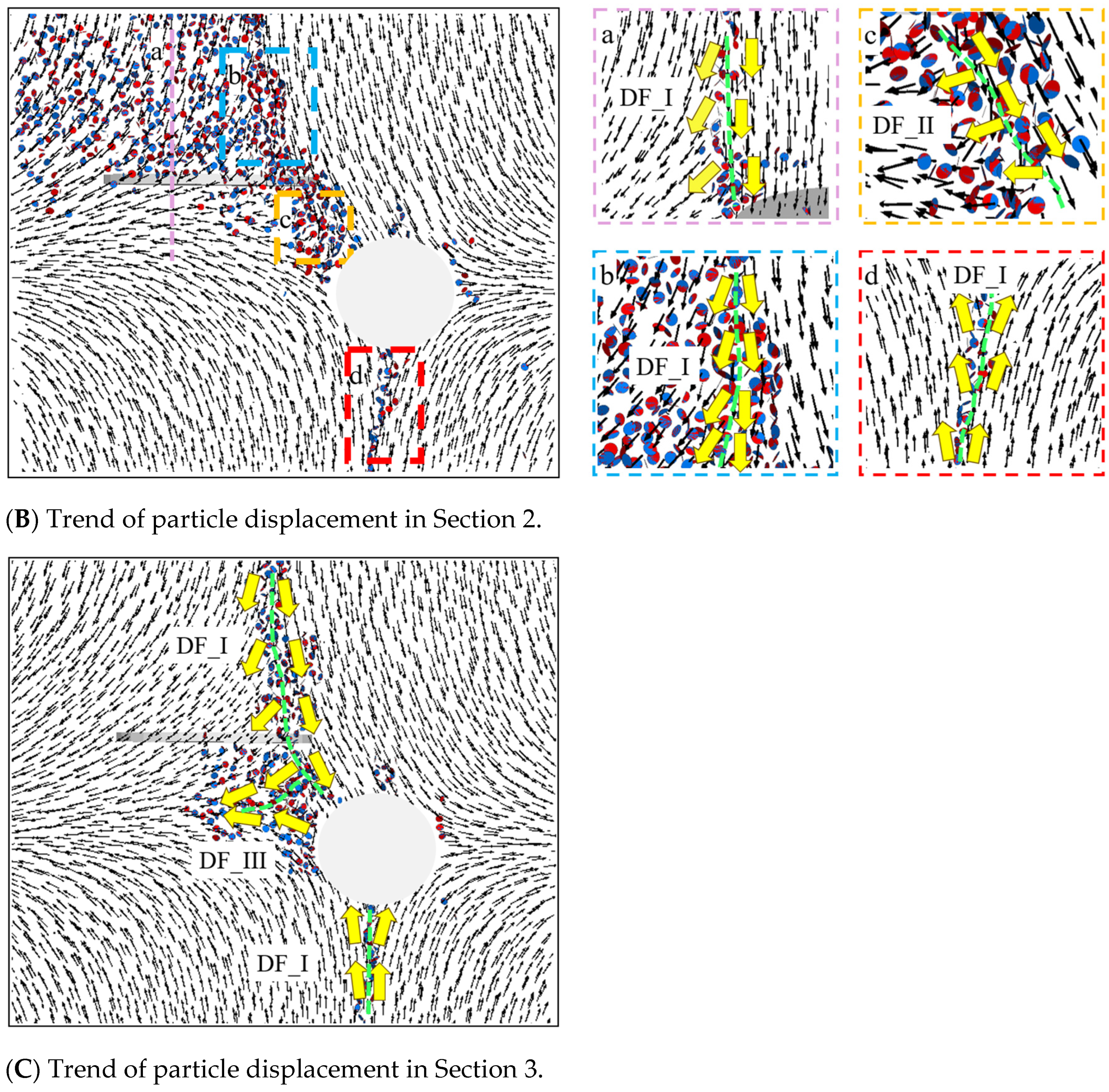
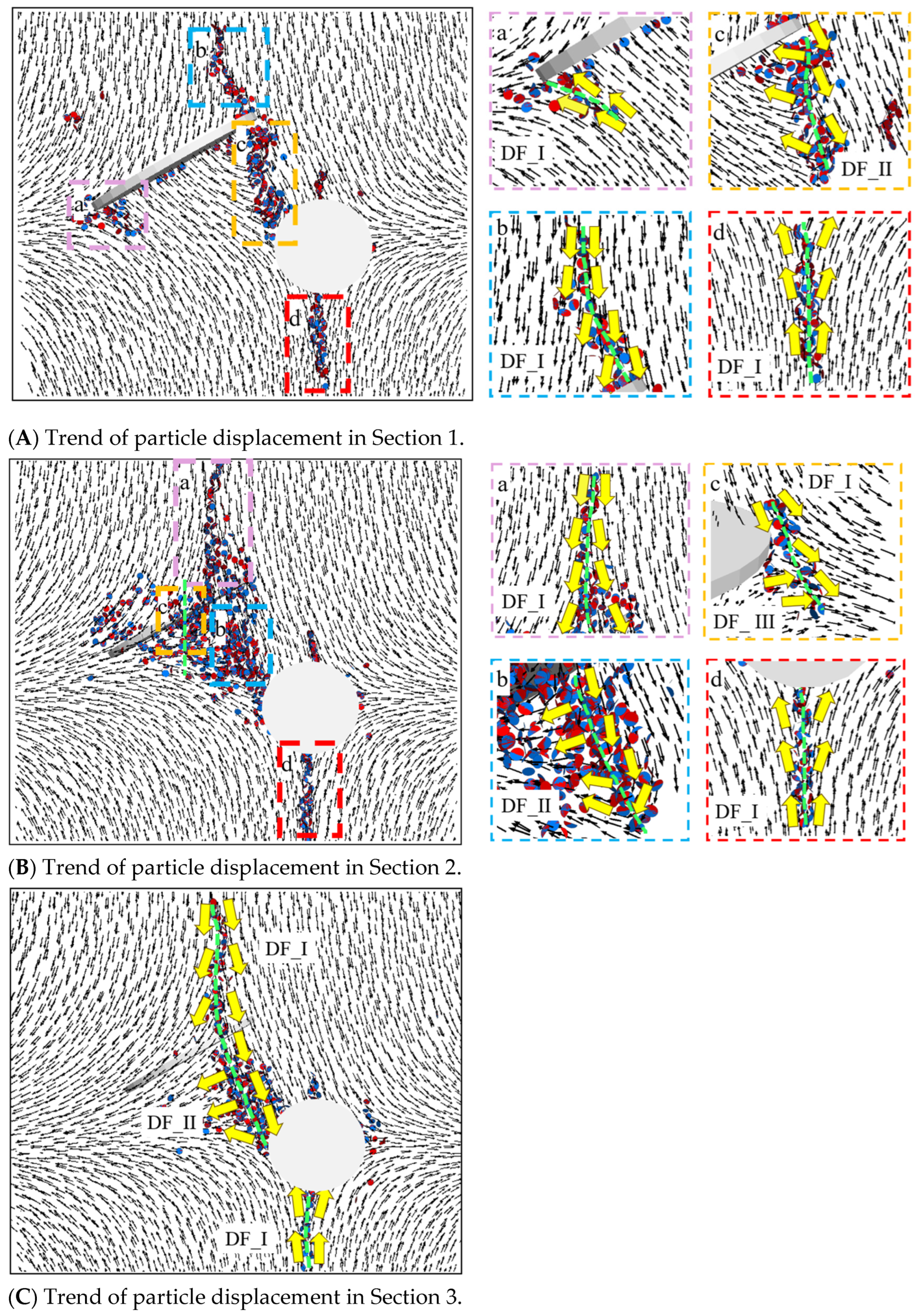
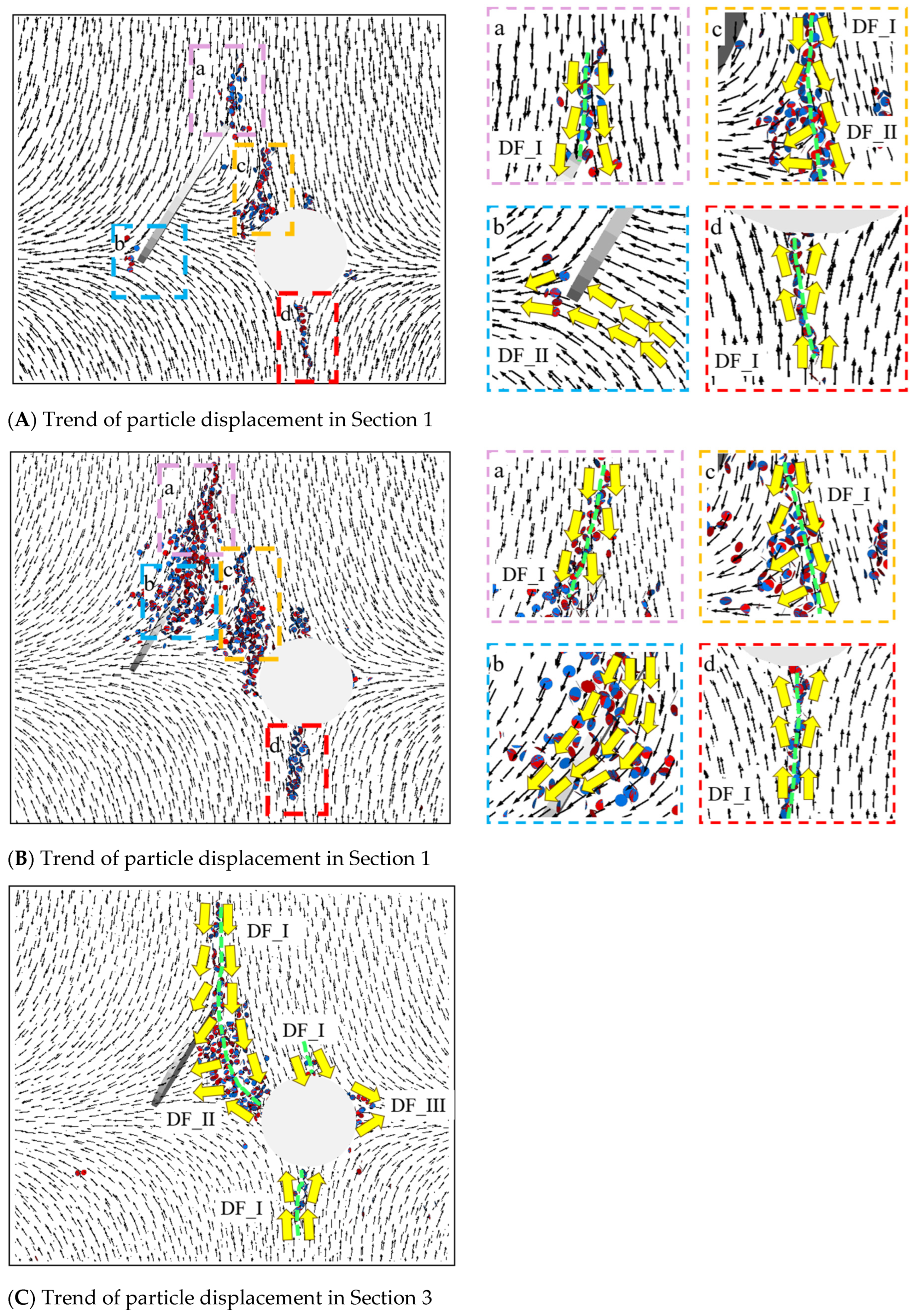
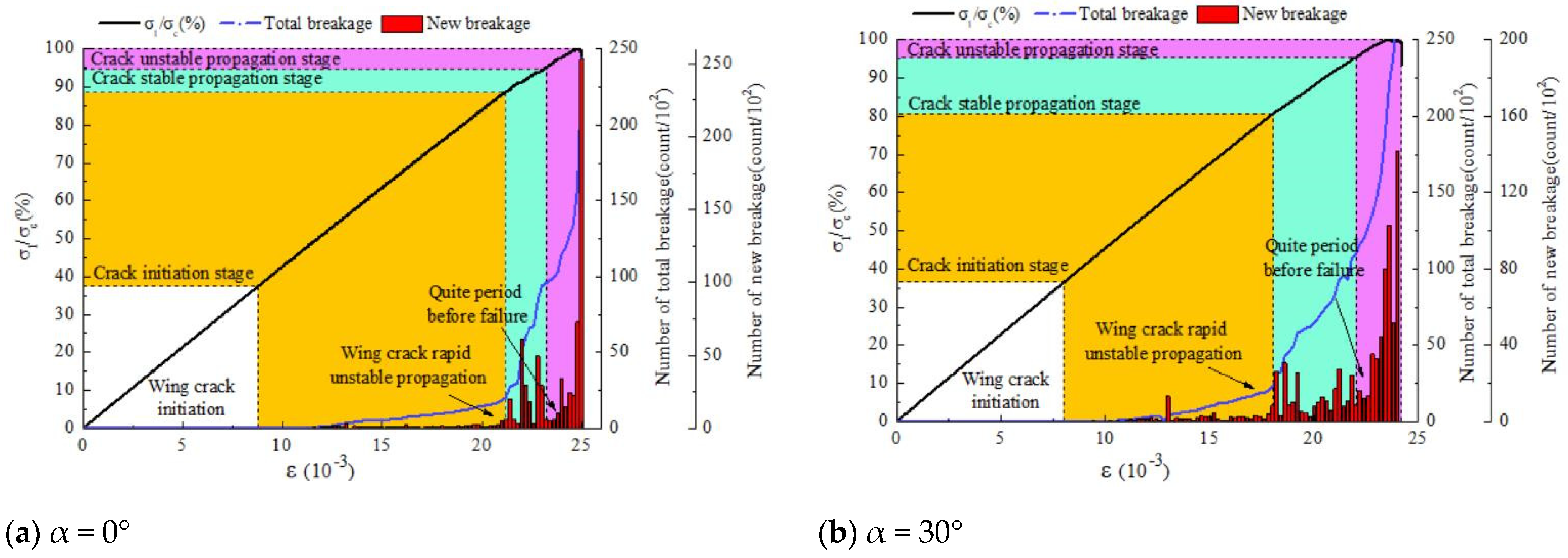
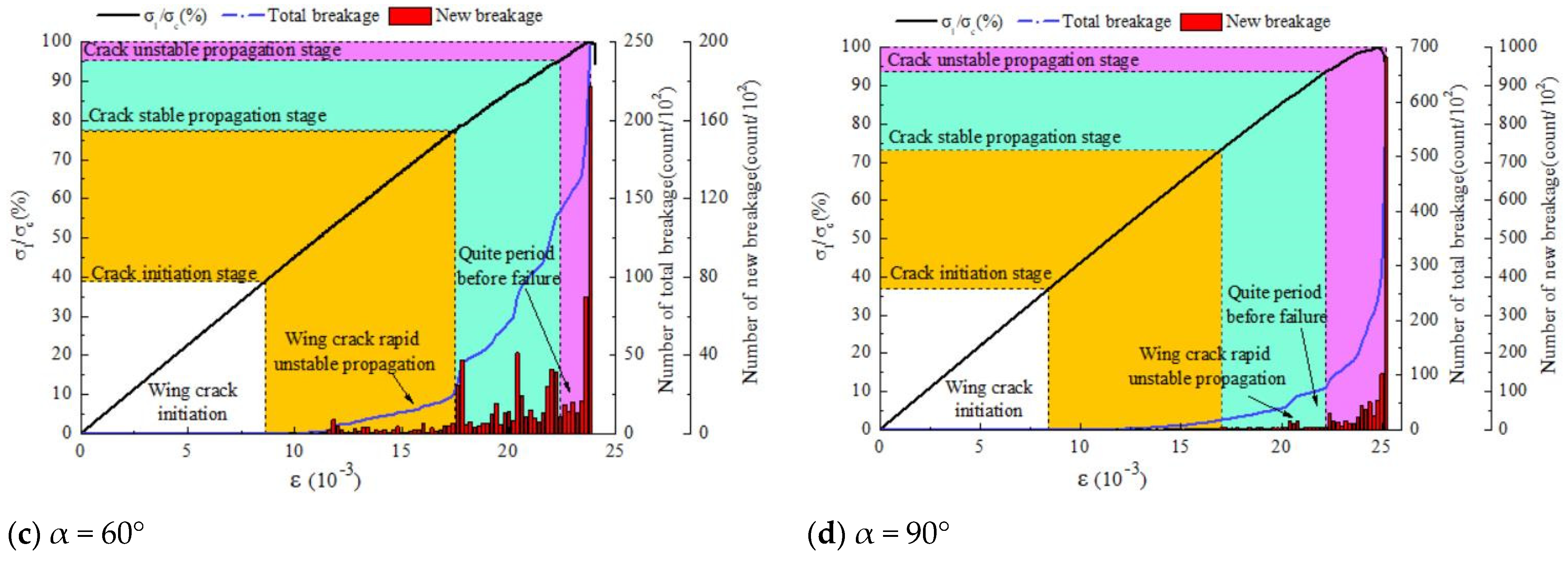
| Density (g/cm3) | Elastic Modulus (GPa) | UCS (MPa) | UTS (MPa) | TCR |
|---|---|---|---|---|
| 1.1 | 3.5 | 116.67 | 9.10 | 12.82 |
| Flat-Joint Model Parameters | Particle Parameters | ||
|---|---|---|---|
| Particle and contact modulus, E∗ (GPa) | 3.5 | Minimum particle diameter, Rmin (mm) | 0.8 |
| Stiffness ratio of the particle and contact, kn/ks | 2 | Maximum to minimum particle diameter ratio, Rmax/Rmin | 1.2 |
| Tensile strength of the contact, σc (MPa) | 30 | Radius multiplier, λ | 1.0 |
| Cohesion of the contact, C (MPa) | 33 | Particle density, ρ (g/cm3) | 2.7 |
| Friction angle of the contact, φ (°) | 30 | Friction coefficient, μ | 0.5 |
| Number of elements in the radial direction, Nr | 2 | - | - |
| Number of elements in the circumferential direction, Na | 4 | - | - |
| Stage | View | UCS 60% | UCS 80% | UCS 100% |
|---|---|---|---|---|
| α = 0° | Top view |  |  |  |
| Front view |  |  | 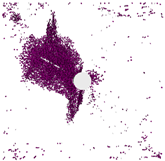 | |
| α = 30° | Top view |  |  |  |
| Front view |  |  | 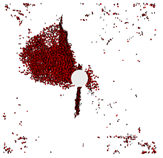 | |
| α = 60° | Top view |  |  |  |
| Front view |  | 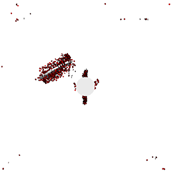 |  | |
| α = 90° | Top view |  |  |  |
| Front view | 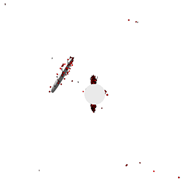 | 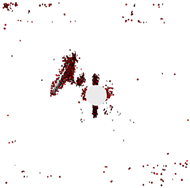 | 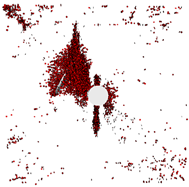 |
| Pre-Existing Crack Inclination α(°) | Increment of σi/σc (%) | |||
|---|---|---|---|---|
| Compaction Stage | Crack Initiation Stage | Crack Stable Propagation Stage | Crack Unstable Propagation Stage | |
| 0 | 36.8 | 36.5 | 20.4 | 6.3 |
| 30 | 38.9 | 38.4 | 17.9 | 4.8 |
| 60 | 36.5 | 44.0 | 14.9 | 4.6 |
| 90 | 37.6 | 51.1 | 6.3 | 5.0 |
Disclaimer/Publisher’s Note: The statements, opinions and data contained in all publications are solely those of the individual author(s) and contributor(s) and not of MDPI and/or the editor(s). MDPI and/or the editor(s) disclaim responsibility for any injury to people or property resulting from any ideas, methods, instructions or products referred to in the content. |
© 2024 by the authors. Licensee MDPI, Basel, Switzerland. This article is an open access article distributed under the terms and conditions of the Creative Commons Attribution (CC BY) license (https://creativecommons.org/licenses/by/4.0/).
Share and Cite
Maimaitiyusupu, S.; Zhu, Z.; Ren, X.; Zhang, H.; Zhu, S. Analysis of Micro-Evolution Mechanism of 3D Crack Initiation in Brittle Materials with Hole under Uniaxial Compression. Materials 2024, 17, 920. https://doi.org/10.3390/ma17040920
Maimaitiyusupu S, Zhu Z, Ren X, Zhang H, Zhu S. Analysis of Micro-Evolution Mechanism of 3D Crack Initiation in Brittle Materials with Hole under Uniaxial Compression. Materials. 2024; 17(4):920. https://doi.org/10.3390/ma17040920
Chicago/Turabian StyleMaimaitiyusupu, Semaierjiang, Zhende Zhu, Xuhua Ren, Hui Zhang, and Shu Zhu. 2024. "Analysis of Micro-Evolution Mechanism of 3D Crack Initiation in Brittle Materials with Hole under Uniaxial Compression" Materials 17, no. 4: 920. https://doi.org/10.3390/ma17040920
APA StyleMaimaitiyusupu, S., Zhu, Z., Ren, X., Zhang, H., & Zhu, S. (2024). Analysis of Micro-Evolution Mechanism of 3D Crack Initiation in Brittle Materials with Hole under Uniaxial Compression. Materials, 17(4), 920. https://doi.org/10.3390/ma17040920





